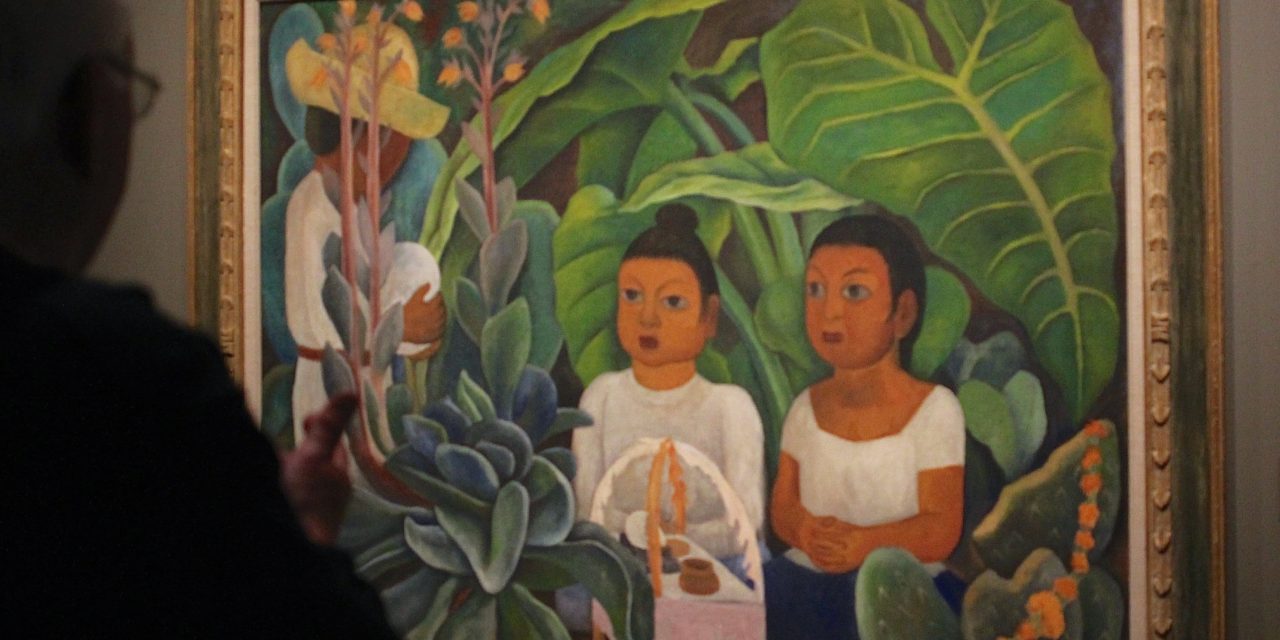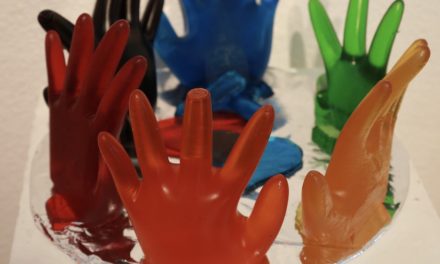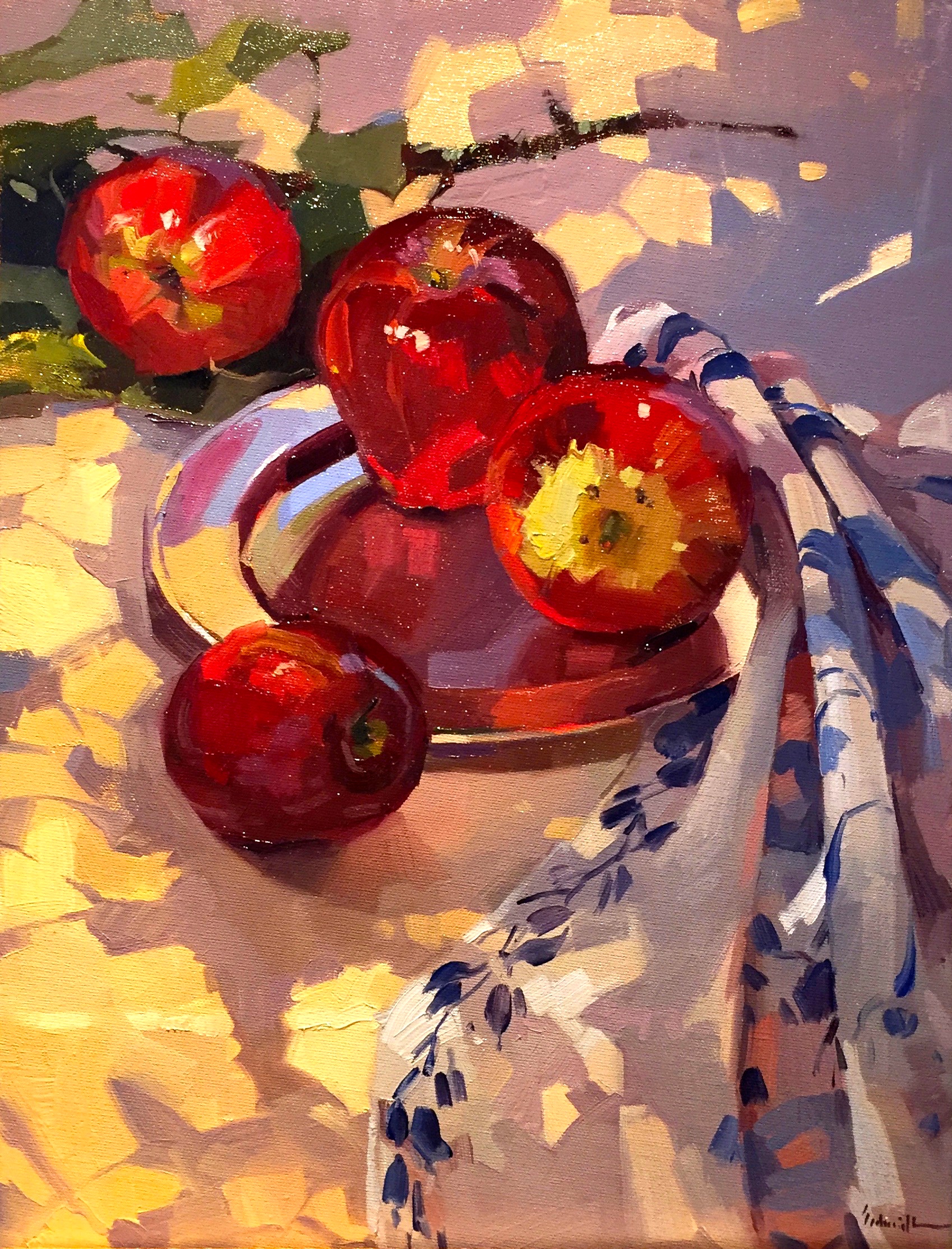(Above: Eugene artist Robert Canaga particularly admires the lush color and texture of Diego Rivera’s La Ofrenda, on loan to the Jordan Schnitzer Museum of Art at the University of Oregon)
By Randi Bjornstad
Many paintings by the masters eventually disappear into private collections all over the world, sometimes never — or at least rarely — to be seen again.
But thanks to “Masterworks on Loan,” a program of the Jordan Schnitzer Museum of Art on the University of Oregon campus, visitors to the gallery regularly get the chance to see artwork by internationally known artists from many eras whose private owners lend them for showing, often in exchange for tax write-offs.
The selection changes periodically, so seeing them all requires periodic visits to the museum.

Cordelia Pries, studio assistant to painter Robert Canaga, gets a close-up look at a painting on loan, Cecily Brown’s The Human Seasons
Eugene painter Robert Canaga and his studio assistant, Cordelia Pries, recently did a walk-through to see what was on the walls then, and share their opinions.
They stopped briefly at an oil painting by contemporary British artist Cecily Brown.
“Sometimes I find her work a bit difficult,” Canaga said pensively, gazing at the The Human Seasons, a vigorous riot of color that partially obscures the many human figures within it. “It’s the way she uses colors and the emotions they bring out in me.”
Pries admired the technique, but agreed that “it does seem a little violent with all those bodies in the reds and oranges.”
Looking at a nearby Keith Haring painting, a much simpler construction of almost drawn figures in red on white, Canaga recalled the artist’s life, which was stimulated by his engineer father’s hobby of cartoon drawing that led to his own fascination with street art and pop art.
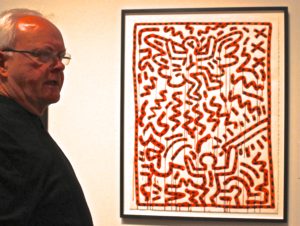
Robert Canaga recalls the life and career of Keith Haring, who created this acrylic on paper, Untitled
“He started out doing graffiti in the subway, and he would give his
work away,” Canaga said of Haring, who died of AIDS in 1990 at age 31, but not before his work became internationally known.
Walking through the substantial exhibit, Canaga and Pries enjoyed a piece by Jean Dubuffet titled Symbiose and raved about two works by Mark Bradford, one called You know what? I quit … problem solved that evoked an impressionistic map with streets and rivers and the other, Plan View 74, vaguely reminiscent of a highly artistic circuit board.
“I like his process,” Canaga said. “It’s layers and layers and layers, and then suddenly he’s through — it’s done.”

Canaga appreciates David Hockney’s color and composition; Pries likes his graphic art better
A piece by David Hockney caught both their eyes, but for different reasons. To Canaga, Late November Tunnel appealed for its use of space and vivid colors,especially the successful rendition of sun on tree branches and the fact that it was done in Hockney’s more traditional painting style. “I like his older work,” he said. “Now, Hockney does a lot with an iPad, and to me it just isn’t the same.”
Pries demurred. “It doesn’t draw me in like his graphic stuff,” she said.
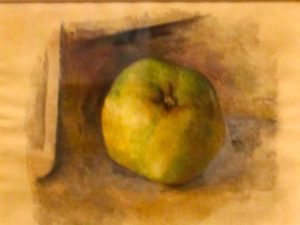
Pablo Picasso’s 1914 painting, Pomme, is proof of the artist’s ability as a “traditional” painter
But neither could argue with the beauty of Pablo Picasso’s 1914 painting of an apple, simply called Pomme.
“I think this is one of the most important pieces in the museum,” Canaga said. “It belies the frequent criticism of Picasso that he didn’t really know how to paint. Of course he did. And then sometimes he would go off on wild, crazy impulses, and then back to the fundamentals again.”

Tête, or “head,” is one of only 25 sculptures created by artist Amedeo Modigliani late in his career
That’s a tactic familiar to many painters, including himself, Canaga said. “As a painter, it seems necessary to come back and touch reality once in awhile. For me, it means coming back occasionally to landscapes.”
One of the most surprising — and breathtaking — pieces on display recently in the Masterworks on Loan section is a bust, titled simply Tête, or Head, sculpted by Amedeo Modigliani around 1911-12, one of only 25 sculptures he created in the decade from 1904 to 1914, when his health was in decline.
The exhibit ranges all over, from the caustic street art of Jean-Michel Basquiat to a sumptuous impressionistic landscape by Alfred Sisley, from what Canaga called Raoul Dufy’s “art for tourists” to Spanish artist Juan Gris’ exploration of cubism, in Le tapis vert.

Spanish painter Juan Gris’ Le tapis vert, is a study in the Cubist style
But what riveted Canaga’s attention most, in a small room adjacent to the exhibit, was Diego Rivera’s painting called La Ofrenda, translated as “the offering.” This painting also is on loan to the Jordan Schnitzer Museum of Art, but through a different program.
“I’ve never really been a huge fan of Diego Rivera, although I do admire his work,” Canaga admitted. “But when you see his murals and his historical paintings, it’s a lot different feeling from something like this, where you can get up really close and see the fragility and beauty and subtlety of his technique.”
He pointed to the lush, velvety leaves in the lower left-hand corner of the painting and the subtle halo around the heads of the children.

The subtle texture of the leaves in Diego Rivera’s La Ofrenda, painted in 1913, are what painter Robert Canaga admires most in the famous painter’s oeuvre
“That’s the kind of thing you just don’t get to see and really appreciate unless you are with the painting,” Canaga said.
That’s one the beauties in general that the Masterworks on Loan program offers, the Schnitzer museum’s communications manager, Debbie Williamson Smith, said.
“It’s an amazing experience to be in this place with all these fantastic pieces of art by some of the world’s greatest artists,” she said. “Every time I go through this exhibit, I can’t believe how lucky we are to have this fabulous resource in this community.”
Masterworks on Loan
When: Continually on exhibit, but works on view change periodically
Where: Jordan Schnitzer Museum of Art, 1430 Johnson Lane, University of Oregon campus, Eugene
Hours: 11 a.m. to 8 p.m. Wednesday 11 a.m. to 5 p.m. Thursday through Sunday
Admission: $5 adults, $35 senior citizens, free for children and UO students, faculty and staff
Current Masterworks on Loan: jsma.uoregon.edu/MOL

Cordelia Pries gives her rapt attention to one of Mark Bradford’s most recent creations, You know what? I quit … problem solved

